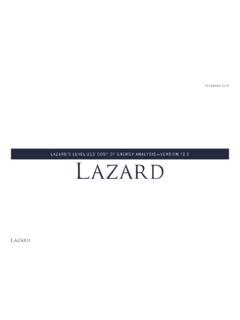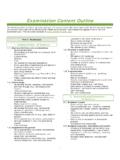Transcription of LB&I International Practice Service Process Unit – Audit
1 DRAFT LB&I International Practice Service Process unit Audit IPS Level Number Title UIL Code Number Shelf N/A Business Inbound Volume 7 Inbound Financing Level 1 UIL 9423 Part interest Expense Limitation under 163(j) and Application of 267(a)(3) to interest Level 2 UIL Chapter interest Expense Limitation Computation under 163(j) Level 3 UIL N/A Sub-Chapter N/A N/A unit Name interest Expense Limitation Computation under 163(j) Document Control Number (DCN) (2016) Date of Last Update 01/06/16 Note: This document is not an official pronouncement of law, and cannot be used, cited or relied upon as such. Further, this document may not contain a comprehensive discussion of all pertinent issues or law or the IRS's interpretation of current law. 1 DRAFT Table of Contents (View this PowerPoint in Presentation View to click on the links below) Process Overview Determination of Process Applicability Summary of Process Steps Process Steps Other Considerations and Impacts to Audit Training and Additional Resources Glossary of Terms and Acronyms Index of Related Issues 2 DRAFT Process Overview interest Expense Limitation Computation under IRC 163(j) Process Description Foreign businesses often capitalize their subsidiaries (USS) with both equity and intercompany debt.
2 The use of intercompany debt may allow for deductible interest expense which reduces taxable income. Such related party debt may be from the foreign parent company or one of its offshore affiliates, often in a low tax jurisdiction. This Practice unit examines the Process of computing the limitation and deferral of deductible corporate interest expense under IRC 163(j) in a given tax period. interest expense attributable to bona fide debt between a Taxpayer (borrower) and its for eig n parent/affiliate (lender) is limited to interest considered paid under the cash method of accounting regardless of the Taxpayer s overall method of accounting, under IRC 267(a)(3) or IRC 163(e)(3), related to Original Issue Discount (OID) instruments. Provisions which defer the deductibility of interest under these sections apply before the application of IRC 163(j).
3 The purpose of IRC 163(j) is to limit the deductibility of interest by a thinly capitalized corporation where the interest is paid to a related payee that is totally or partially exempt from tax on the distribution. Additionally, IRC 163(j) applies to interest that is paid or accrued to an unrelated person if there is a disqualified guarantee on the debt and no gross basis tax is imposed on such interest . Disqualified Guarantee is discussed in detail later on in Process Step 5 of this IPS unit . Generally, the taxpayer will calculate its interest Expense limitation under the rules provided by IRC 163(j). This Process unit explores the computation and the key components of the interest expense limitation prescribed by IRC 163(j) and Proposed Treas. Regulations (j). The calculation is based on the statutory formula and amounts reported on Form 8926, Disqualified corporate interest Expense Disallowed Under IRC 163(j).
4 Furthermore, this Process unit will cover Audit techniques during various steps of the computation of the IRC 163(j) limitation. Back to Table Of Contents 3 DRAFT Process Overview (cont d) interest Expense Limitation Computation under IRC 163(j) Process Description For IRC 163(j) to apply, the following conditions must be satisfied: A corporation or a branch of a foreign corporation must pay interest to: a related person, or to an unrelated person (such as a third party bank) if there is a "disqualified guarantee" of the underlying debt; The payee above must be exempt from tax on some portion of the income (or subject to a reduced rate of tax under a treaty). The payer corporation does not meet the debt equity ratio safe harbor ( or less), and The corporation s net interest expense exceeds 50% of adjusted taxable income (ATI) plus any excess limitation (EL) carryforward.
5 Disallowed interest expense is carried over to future years and treated as interest paid or accrued in the succeeding taxable year. The examiner should determine early on in the Audit Process by reviewing t he balance sheet and the income statement of the Taxpayer the total amount of intercompany debt and interest deduction reported. In addition, Form 8926 should be reviewed to determine if there is Disqualified interest , a Disqualified Guarantee, or a carryforward of Disqualified interest from a previou s year affected by the limitations of IRC 163(j). This will allow the examiner to determine the tax impact of any potential adjustment. IRC 163(j) was first enacted by the Omnibus Act of 1989. Proposed Regulations were issued in June 1991. The regulations have not yet been finalized. See Chief Counsel Notice (CC-2003-014) dated May 8, 2003 for the effect of proposed regulations.
6 Back to Table Of Contents 4 DRAFT FP USS (Foreign controlled) Loan interest Process Overview (cont d) interest Expense Limitation Computation under IRC 163(j) Example Circumstances Under Which Process Applies Note: A variation of the Example Circumstances, includes the same structure, but with a third party lender (such as a bank) instead of FP, and the loan is instead Guaranteed by the FP or related party. In any event, the overall Process of determining the interest Expense Limitation under IRC 163(j) is still the same. Back to Table Of Contents 5 DRAFT Determination of Process Applicability interest Expense Limitation Computation under IRC 163(j) The following criteria should be verified before determining if 163(j) applies. Criteria Resources 6103 Protected Resources Taxpayer is claiming an interest expense deduction on its books and/or Form 1120 The limitations under IRC 267(a)(3) and IRC 163(e)(3) have already been considered in determining interest expense as applied below.
7 For I RC 163(j) to apply, the following conditions must be satisfied: A corporation or a branch of a foreign corporation must pay interest to: Form 1120 Line 18 Form 1120, Sch. L Form 5472 Line 19 (2011) Form 8926 (2011) Form 1042-S (2011) Taxpayer Financial Statements, (corresponding t o Form 1120, Sch. M-3 a related person, or an unrelated person (such as a third party bank) if there is a "disqualified guarantee" of the underlying debt; The payee above must be exempt from tax on some portion of the income (or subject to a reduced rate of tax under a treaty). The payer corporation must have a debt-to-equity ratio of more than to 1 and The payer corporation must have net interest expense that exceeds the sum of 50% of adjusted taxable income plus any excess limitation carryforward. Back to Table Of Contents 6 DRAFT Summary of Process Steps interest Expense Limitation Computation under IRC 163(j) Step 1 Determine the Debt to Equity Ratio Step 2 Determine the Net interest Expense Step 3 Determine Adjusted Taxable Income Step 4 Determine Excess interest Expense Back to Table Of Contents 7 DRAFT Summary of Process Steps (cont d) interest Expense Limitation Computation under IRC 163(j) Step 5 Determine Disqualified interest and/or interest subject to a Disqualified Guarantee Step 6 Determine Total Disqualified interest for the tax year Step 7 Determine interest deduction Disallowed under IRC 163(j) for the current year and carried forward to the next tax year.)
8 Step 8 Determine Excess limitation for the current year and Excess limitation carryforward to the next tax year. Back to Table Of Contents 8 DRAFT Step 1 interest Expense Limitation Computation under IRC 163(j) Step 1: Determine the Debt to Equity Ratio The Debt to Equity Ratio involves a factual determination using the rules and computation discussed below. Considerations Resources 6103 Protected Resources For the IRC 163(j) interest Expense limitation to apply, the Debt Equity ratio must exceed This is determined on the last day of the taxable year. The debt-equity ratio is determined as follows: Debt Equity Ratio = Total Debt = Total Debt Total Equity (Cash + Other Assets) - Debt The term Debt means the corporation s liabilities determined under general tax principles, and as the adjusted Issue Price in the case of a discounted bond.
9 The term Equity includes cash and adjusted basis of all other assets, minus Total Debt determined above. IRC 163(j)(2)(A) Form 8926, Lines (1a-1f) IRC 163(j)(2)(C) Audit Tip: At each step, it is often helpful to use Form 8926 and any supporting workpapers as the starting point. Back to Table Of Contents 9 DRAFT ? Step 1 (cont d) interest Expense Limitation Computation under IRC 163(j) Step 1: Determine the Debt to Equity Ratio The Debt to Equity Ratio involves a factual determination using the rules and computation discussed below. Considerations Resources 6103 Protected Resources Debt to Equity ratio Form 8926, Line 1f DECISION POINT: If the Debt to Equity Ratio exceeds , Disqualified interest paid or accrued in the current tax year will be disallowed (and treated as Disqualified interest in succeeding years) by IRC 163(j) to the extent the corporation has excess interest expense for the current tax year.
10 If the ratio is exactly or less disqualified interest paid or accrued in the current tax year will not be disallowed by IRC 163(j). In any event, the Process and computation should be completed to determined the correct Excess Limitation carryforward or Disqualified interest carryforward disallowed. IRC 163(j)(2)(A) Form 8926, Lines (1a-1f) IRC 163(j)(2)(C) Audit Tip: At each step, it is often helpful to use Form 8926 and any supporting workpapers as the starting point. Back to Table Of Contents 10 DRAFT Step 1 (cont d) interest Expense Limitation Computation under IRC 163(j) Step 1: Determine the Debt to Equity Ratio The Debt to Equity Ratio involves a factual determination using the rules and computation discussed below. Considerations Resources 6103 Protected Resources Audit Tips:Consider the following criteria to determine if the taxpayer has a potential and material IRC 163(j) issue: A large interest deduction.
















